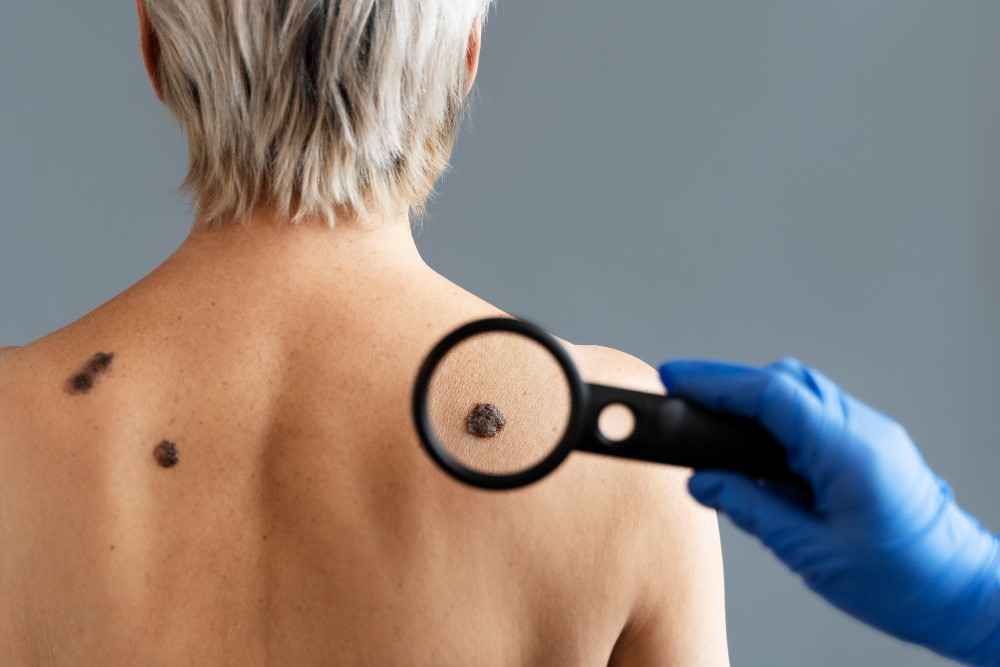Skin cancer is a common condition that can affect anyone, but understanding its types and risks can help in prevention and early action. There are three main types of skin cancer: basal cell carcinoma, squamous cell carcinoma, and melanoma.
Basal cell carcinoma is the most common. It usually grows slowly and seldom spreads to other parts, but it can cause damage if untreated. Squamous cell carcinoma is more aggressive than basal cell and can spread if not addressed. Melanoma is the most dangerous type and develops in the cells that give your skin its color. It can spread quickly to other parts, making early detection crucial.
Skin cancer causes include both genetic and environmental factors. Genetics play a role if you have a family history of skin cancer, increasing your chances of developing it. Environmentally, overexposure to the sun’s ultraviolet (UV) rays is a primary factor. In India, where sunlight can be intense, people need to be especially cautious.
Certain conditions also increase risk, like fair skin, freckles, or a tendency to sunburn easily. Understanding the early signs of skin cancer can save lives. These signs include changes in skin spots or moles, including those that grow larger or change color. High-risk groups include individuals with a history of sunburns, those with many moles, and people with weakened immune systems.
Recognizing the Symptoms: A Comprehensive Checklist and Detection Methods
Spotting early signs of skin cancer is key in its management. One effective method is to follow the ABCDEs of melanoma:
- Asymmetry: One half of the mole does not match the other.
- Border: The edges are ragged, notched, or blurred.
- Color: There’s an uneven color pattern.
- Diameter: Moles larger than a pencil eraser should be checked.
- Evolution: Any change in size, shape, or color.
Additionally, be aware of the ‘Ugly Duckling Sign’—a mole that looks different from others on your body.
Having a skin cancer symptom checklist can be a practical tool. This might include:
- New spots that are unusual.
- Existing moles that start to itch or bleed.
- Open sores that do not heal for weeks.
- Redness or swelling beyond the border of a mole.
Performing a self-exam monthly is a good practice. Use a mirror to check all areas, including the back and the scalp, to detect skin cancer symptoms effectively. Checking often helps spot changes immediately. Skin cancer detection methods also include photography. Take pictures of moles at regular intervals to track any changes over time.
The Importance of Timely Medical Consultation and Preventive Measures
Seeking medical advice early makes a big difference in skin health outcomes. Regular check-ups can help in the detection of skin cancer symptoms before they become severe. Early finding means treatment is simpler and more effective.
Preventing skin cancer involves several easy steps. Apply sunscreen with a minimum SPF of 30, even on cloudy days, to block harmful UV rays. Wearing protective clothing, like long-sleeved shirts and broad hats, also helps. Avoid sun exposure during peak sun hours, typically from 10 a.m. to 4 p.m.
In India, there are affordable skin cancer treatment options available. Many clinics offer screening at a low cost, making it accessible for more people. Treatments vary depending on cancer type and stage but often include surgery to remove cancerous spots.
Simple lifestyle changes can further lower risk. Eating a balanced diet rich in fruits and vegetables helps improve skin health. Staying hydrated also keeps skin looking healthy. Quitting smoking can significantly cut down cancer risks and improve overall wellbeing.
Recent Advances in Skin Cancer Detection and Treatment Options
Recent breakthroughs in medical technology provide new skin cancer detection methods. Digital mole analysis and smartphone applications help detect changes without a visit to the doctor. These tools can compare data over time, highlighting changes instantly.
Skin cancer treatment options have also improved. Scientists are researching immunotherapy, which uses the body’s immune system to fight cancer. This method can be effective for advanced cases, offering hope for long-term remission.
Innovative technology, like artificial intelligence, enhances diagnosis accuracy, resulting in quicker, more precise outcomes. AI can spot subtle changes often missed by the naked eye, enabling earlier treatments.
Research continues to focus on prevention and early action. Preventative vaccines and creams are under study, aiming to stop the disease before it starts. These advances offer significant potential to improve personal health and general skin care.
By staying informed about new technologies and treatments, you empower yourself with knowledge. While avoiding complex jargon, simple awareness and action can contribute greatly in both prevention and treatment of skin cancer.
